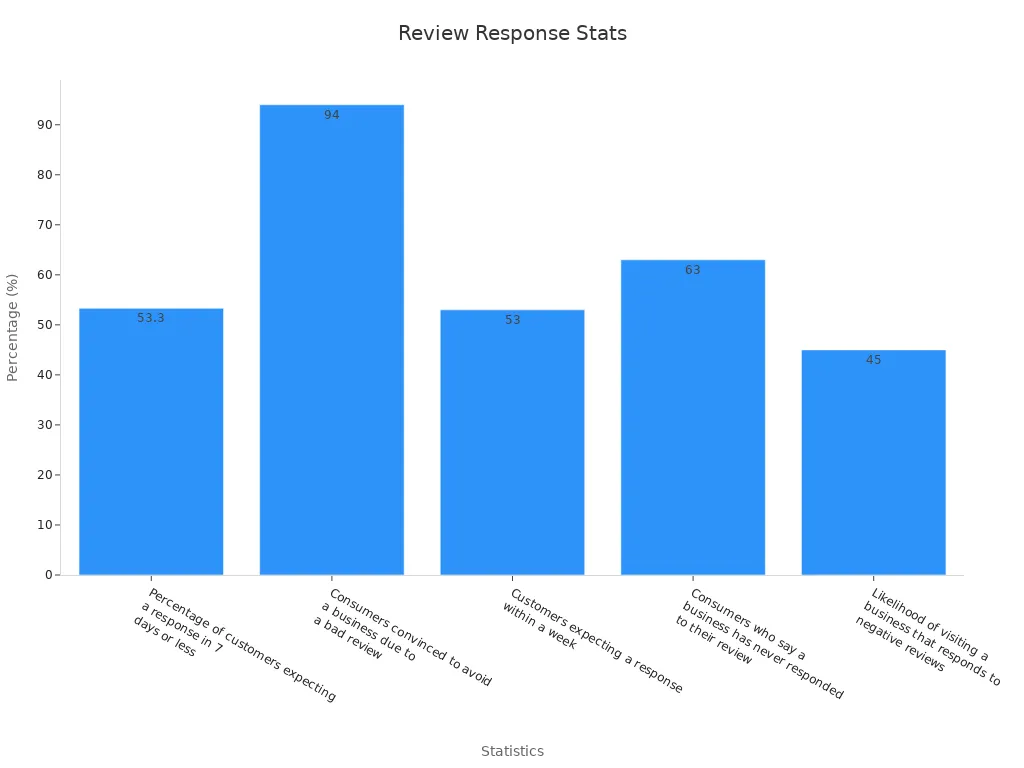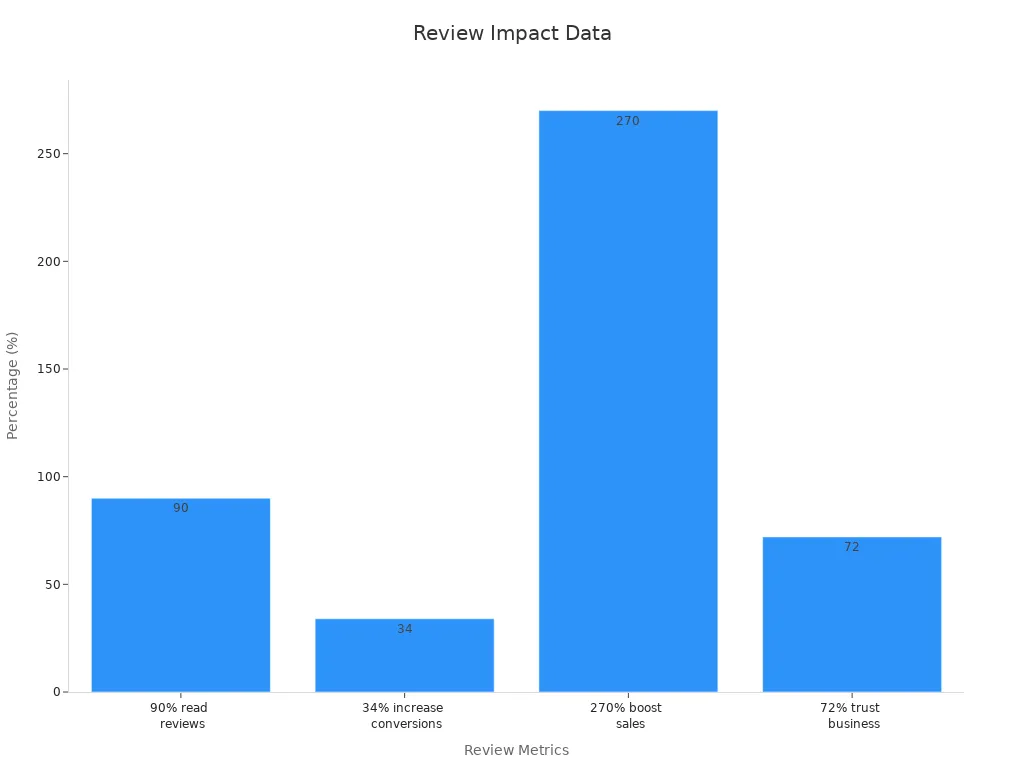Responding to Negative Reviews: A Step-by-Step Guide

Negative reviews affect your business in many ways. They stop 94% of online shoppers from visiting your store. About 86% avoid buying from businesses with bad reviews. Responding to negative reviews keeps your image positive. It shows you care about customer happiness and listen to them. Complaints from unhappy customers provide helpful ideas to improve your services and gain trust.
The Impact of Negative Reviews on Businesses

Loss of Potential Customers
Bad reviews can scare away new customers. About 64% of people read reviews before picking hotels. Over half of Danes check reviews before trips. By 2025, 85% of people may trust reviews like personal advice. But 60% of people avoid businesses with bad reviews. This can cause fewer sales. For example, if 300 people visit your site but only 30 buy, that's a 90% drop-off rate. This shows how bad reviews can hurt your chances of getting new customers.
Decreased Sales and Revenue
Bad reviews lower your sales and income. Studies say 94% of people avoid businesses with bad reviews. Only 9% of people try businesses with 1 or 2 stars. Unhappy customers are 2-3 times more likely to leave bad reviews. This creates a cycle where bad reviews scare off new customers, cutting revenue. For instance, a subscription service cut its customer loss by 15% after fixing problems. This shows how solving issues can help your earnings.
Damage to Brand Reputation
Your reputation is very important. Bad reviews can harm it and make trust harder to earn. Some people ignore bad reviews from faraway customers, but not always.
Influence on Search Engine Rankings
Bad reviews can lower your online visibility. A plastic surgeon lost 23% of website visits due to one bad review. Good reviews, however, can boost clicks by 25%. Search engines favor businesses with good reviews because they seem trustworthy. Managing reviews well can protect your reputation and improve your online presence.
Why Responding to Negative Reviews Matters
Building Trust and Credibility
Replying to bad reviews shows you care about customer opinions. It proves you take complaints seriously and want to fix problems. This helps build trust with both the reviewer and future customers.
Answering bad reviews with helpful solutions shows you value customers. Offering fixes or refunds can turn a bad experience into a good one.
Talking to unhappy customers also makes your business seem honest. People trust businesses that listen and respond to concerns. Studies say 95% of shoppers read reviews before buying, so trust is key.
Enhancing Customer Retention
When you reply to bad reviews, it shows you value feedback. This makes customers feel important and keeps them coming back. Research says businesses that respond to reviews keep 25% to 30% more customers. When complaints lead to changes, customers feel closer to your brand.
Fixing problems quickly can also win back upset customers. Data shows 95% of unhappy customers return if their issues are solved fast. This proves good communication helps keep customers loyal.
Improving Online Reputation
Quick replies to bad reviews can boost your online image. Answering reviews shows you care about opinions, which builds trust. Businesses that manage reviews well often rank higher on search engines. This brings in more customers.
Gaining Insights for Service Improvement
Bad reviews can teach you how to make your business better. By studying feedback, you can spot common problems and fix them. This not only improves your services but also shows customers you listen.
Data says 68% of people who left bad reviews got a reply. Of those, 18% became loyal customers, and 33% wrote good reviews later. This shows that replying to feedback helps improve services and build stronger customer bonds.
Step-by-Step Guide to Responding to Negative Reviews

Respond Quickly and Politely
It’s important to reply to negative reviews fast. Customers want their problems addressed quickly. If you take too long, they might feel ignored. This can make them even more upset. Studies show 53% of people expect a reply in seven days. Sadly, 63% say they never get a response. This proves how important it is to answer on time.
Being polite is just as important. Don’t use rude or defensive words. Instead, try to understand the problem and offer a helpful solution. A kind and professional reply shows customers you care about their feedback.

Make Your Reply Personal
Generic replies can feel cold and uncaring. Writing a personal response shows you care about the customer’s experience. Use their name and mention details from their review. This makes your reply feel thoughtful and builds trust.
Personal replies can make unhappy customers feel better. A good response can even turn them into loyal fans. Show empathy by understanding their feelings and offering a solution. For example:
"We’re sorry about your experience, [Customer Name]. We know this was frustrating and want to fix it."
Saying sorry and promising to improve can calm upset customers and build a better relationship.
Admit the Problem and Apologize
The first step is to admit there’s a problem. Let the customer know you’ve heard them. A simple phrase like, "We understand your frustration," can help calm them down.
Next, say you’re sorry. Don’t make excuses or blame others. Take responsibility and apologize for the trouble caused. For example:
"We’re truly sorry for the inconvenience. Your feedback helps us improve, and we’ll do better."
This shows you care and take their concerns seriously.
Take Ownership and Fix the Problem
Taking responsibility shows you’re accountable and trustworthy. Don’t blame others or make excuses. Focus on solving the customer’s issue.
For example, if a product is broken, offer a replacement or refund. If the problem is with service, give a discount or free service. Fixing the issue shows you care about making things right.
Explain and Ask for More Feedback
Sometimes, customers don’t know all the details about an issue. Explaining the situation can clear up confusion. For example, if a delay happened because of bad weather, let them know. Being honest builds trust.
Ask for more feedback to show you value their opinion. Invite them to share ideas for improvement. For example:
"Thanks for your feedback. We’d love to hear more about how we can improve."
This not only solves the problem but also keeps the conversation open.
Move the Discussion Offline When Needed
For big or private issues, it’s better to talk offline. This lets you solve the problem without everyone watching. Publicly acknowledge the issue and ask the customer to contact you directly.
For example:
"We’re sorry about your experience. Please reach out to us at [email/phone] so we can help."
This keeps the customer’s privacy safe and shows you’re serious about fixing the problem.
Stay Polite and Professional
Always be polite when replying to negative reviews. Don’t use rude or defensive words. Instead, be kind and focus on solving the problem.
Thoughtful replies show you value feedback and care about customers. People are six times more likely to change their review if they get a good response.
Positive replies build customer loyalty.
Helpful responses encourage customers to return.
Kind replies improve trust and your business image.
By staying polite, you can turn a bad review into a chance to build a stronger connection with the customer.
Templates for Responding to Negative Reviews
Negative reviews can seem overwhelming, but having response templates helps. Custom replies not only solve customer problems but also show you care. Below are simple templates for different industries to help you reply effectively.
Ecommerce Scenarios
In ecommerce, complaints often involve late deliveries, broken items, or unclear returns. Using specific templates can help you respond quickly and clearly.
Example Template for Shipping Problems:
"Hi [Customer Name], we’re sorry your order was delayed. We understand this is frustrating. Our team is checking the issue and will update you soon. Please contact us at [email/phone] if you need more help. Thanks for your patience!"
Example Template for Product Issues:
"Thanks for your feedback, [Customer Name]. We’re sorry the product didn’t meet your expectations. We’d like to fix this by offering a replacement or refund. Please reach out to us at [contact information] for help."
Custom replies are important in ecommerce because every situation is different:
New customers may need clear explanations and reassurance.
Cart abandoners might respond well to discounts or free shipping offers.
Automated replies can handle common questions like shipping costs or return policies anytime.
Remember, 96% of people say customer service affects loyalty, and 75% expect help fast. Quick and kind replies can turn a bad review into a good experience.
Hospitality and Restaurants
In hospitality and restaurants, reviews often mention service, cleanliness, or food quality. Responding with care and professionalism can rebuild trust.
Example Template for Service Complaints:
"Dear [Customer Name], thank you for sharing your thoughts. We’re sorry our service didn’t meet your expectations. We’ve shared your feedback with our team to improve. Please contact us at [email/phone] so we can make it up to you."
Example Template for Food Quality Concerns:
"Hi [Customer Name], we’re sorry about your dining experience. Your feedback is important, and we’ve already talked to our kitchen staff. We’d love to invite you back for a better visit. Please contact us at [contact information] to arrange this."
Personal replies show customers their opinions matter. Listening to concerns and offering solutions can turn visitors into loyal customers.
Tech Support and Online Services
Negative reviews in tech support often mention unresolved problems, poor communication, or glitches. Clear templates can help you respond effectively.
Example Template for Technical Problems:
"Hi [Customer Name], we’re sorry about the issue you’re facing. Our team is working on a solution and will update you soon. If you have more details, please email us at [contact information]. Thanks for letting us know!"
Example Template for Communication Issues:
"Dear [Customer Name], we apologize for the lack of updates about your issue. We’re reviewing our process to improve service. Please contact us at [email/phone] so we can fix this quickly."
Templates in tech support make replies consistent and clear. Automated messages can also reassure customers their concerns are being handled.
Retail and Beauty Services
Retail and beauty services often get feedback about product quality, appointments, or customer service. Responding kindly and professionally can ease tension and improve your reputation.
Example Template for Product Complaints:
"Hi [Customer Name], thanks for your feedback. We’re sorry the product didn’t meet your expectations. We’d like to offer a replacement or refund to fix this. Please contact us at [email/phone] for help."
Example Template for Service Problems:
"Dear [Customer Name], we’re sorry about your experience. We’ve shared your feedback with our team and are working to improve. Please contact us at [contact information] so we can make things right."
Studies show personal replies make customers feel heard. Apologizing and offering solutions can turn a bad experience into a positive one.
Industry-Specific Examples
Different industries need unique ways to handle negative reviews. Here’s how strategies vary across sectors:
Industry/Sector | Key Goals and Focus |
|---|---|
Upward Airlines | Improve shareholder value, reliable flights, low prices, and faster turnaround times. |
Growing Healthcare Company | Provide easy medical care and expand access for patients in more areas. |
General Hospital | Balance patient care with budget limits, focusing on health outcomes for the community. |
Non-Profit Social Services Organization | Ensure services reach those in need, use volunteers, and influence state policies. |
Local Government | Keep citizens safe, active, and mobile while managing finances responsibly. |
These examples show why replies should match your industry’s goals. Whether fixing a flight delay or addressing healthcare concerns, thoughtful replies make a big difference.
Strategies for Encouraging Positive Reviews
Ask for Feedback After Service
Requesting feedback after a purchase is simple and effective. Send a follow-up email or text to remind customers to share their thoughts. Timing matters—reach out soon after the service while it’s fresh in their mind.
Make it easy by adding a direct link to your review page. For example:
"Thanks for choosing us! Share your experience here: [link]."
Personalized messages show customers their opinions are valued. This method boosts the chance of getting reviews and builds stronger connections.
Provide Great Customer Service
Excellent service leads to positive reviews. When you go above and beyond, customers feel appreciated. Small actions like warm greetings, quick help, and extra effort leave lasting impressions.
If a customer has a problem, solve it fast and offer a thoughtful fix. Happy customers are more likely to write glowing reviews. Remember, satisfied customers often become loyal supporters of your business.
Tip: Train your team to listen carefully and show empathy. These skills turn ordinary experiences into memorable ones.
Share Positive Reviews Online
Posting good reviews on your website or social media builds trust. Reviews act as proof that others enjoy your services. This encourages new customers to leave their own feedback.
Here are some facts:
90% of people read reviews before buying.
Positive reviews can boost sales by 34%.
Showing reviews increases sales by 270%.
72% trust businesses more after reading good reviews.

Displaying reviews builds credibility and inspires customers to share their experiences. This creates a cycle of trust that helps your business grow.
Improve customer satisfaction with print on demand
Improve customer satisfaction with Yoycol's print on demand solution. Yoycol offers a wide range of products, including t-shirts, mugs, home decors, phone cases, tote bags, and hats, ensuring high quality and customization to meet customer preferences.
By leveraging Yoycol’s global network, businesses can provide fast and reliable service, enhancing the overall customer experience. With flexible subscription plans tailored to your needs, you can effortlessly scale your print on demand business.
Sign up for Yoycol today and choose a subscription plan that suits your needs to start delivering exceptional products to your customers.
Bad reviews let you prove you care about customers. Replying fast and kindly builds trust and keeps customers loyal. Answering concerns in public shows you respect their opinions. This can turn unhappy customers into fans and make your brand seem honest and reliable.

